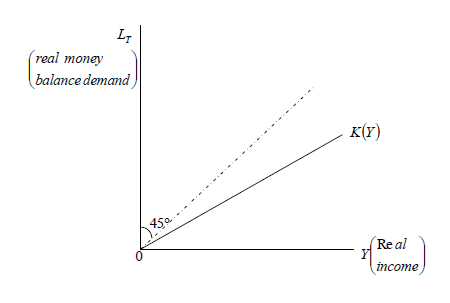1.The transactions motive
-The transactions demand for money shows how much money household want to hold
in order to carry out their day-to-day transactions.
-Keynes borrowed the transactions motive for holding cash balances from Cambridge
quantitative theorist.

Expressing the transaction demand for money in real terms

Since the spending habit of the community changed very little in the short run, the
transaction demand for money was thought to be a constant fraction of the level of
income increased in the economy, households desired to hold more money balance in
order to carry out their day to day transaction.

The slope of the line = k, which is less than 1. Since only some proportion of real
income is held for transactions purpose.
2.The precautionary motive
-Keynes pointed out that household had a precautionary motive for holding money
balances since unforeseen contingencies could arise.
-Unforeseen contingencies meant such emergencies as a long illness, loss of one’s job,
or an automobile accident.
-As the income of the household increase, more money is demanded by it to meet
precautionary needs.
-Thus, the precautionary demand for money can be included in the transaction demand
for money equation, L
T =K(Y)
-Both the transactions demand for money and the precautionary demand for money are
positively related to aid are function of the level of income.
3.The speculative demand for money
-Was Keynes’ most innovative concept. It was mainly based on the idea that the
household faced a world of uncertainty about the future market value of its earning
assets.
-The household had a perception about whether the price of an asset would rise or fall
in value in the future and, therefore, about whether or not it would experience a
capital gain or less when it sold the assets.
-In Keynes’s discussion of the speculative demand for money, the household’s choice
was primarily between two types of assets-bonds or money. By emphasizing the
speculative demand for money, Keynes was departing from the simpler classical
concept and pointing out that the household could view money as an asset. Money
was therefore performing a store-of-value function.
sharon kalunda answered the question on
April 11, 2019 at 12:15